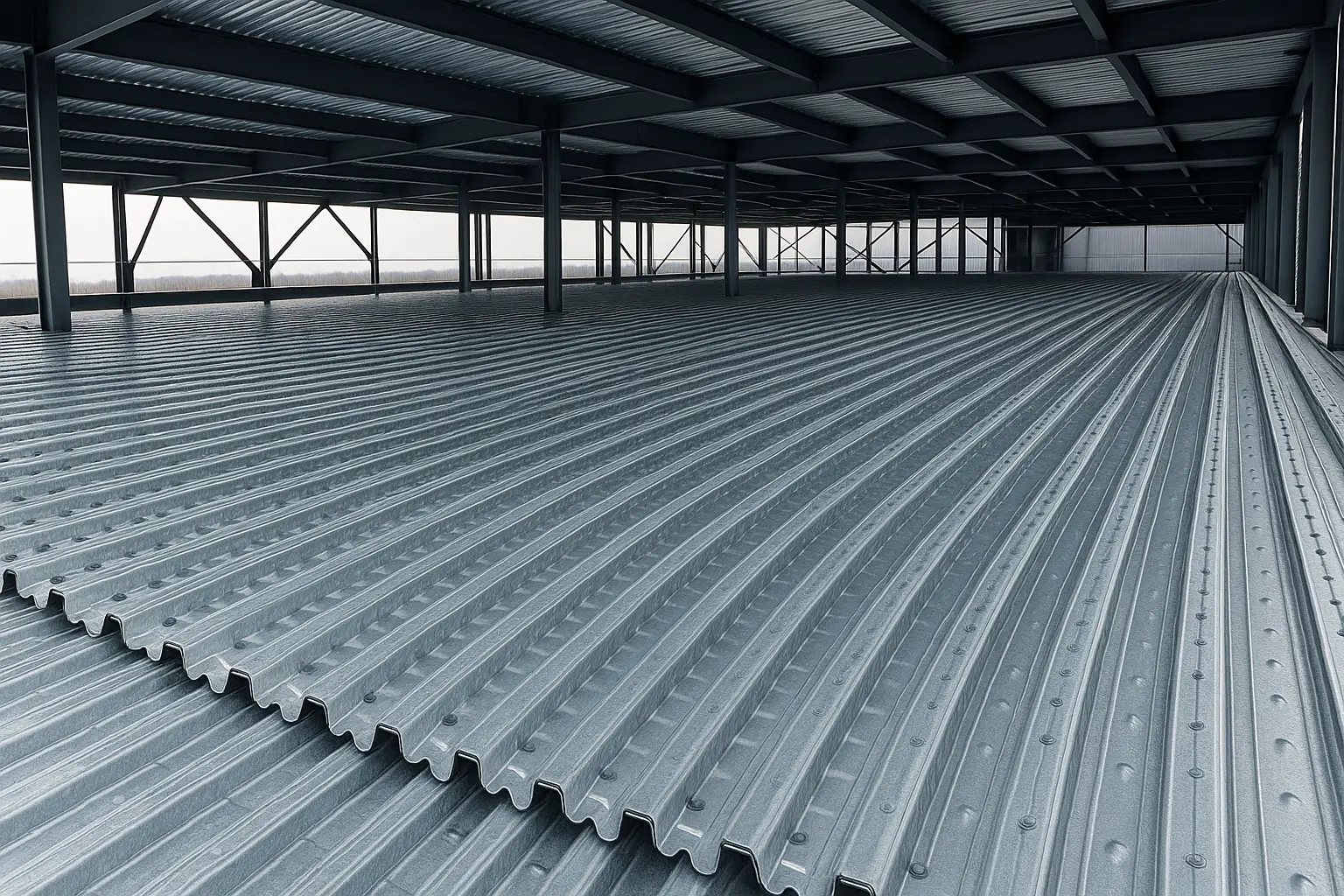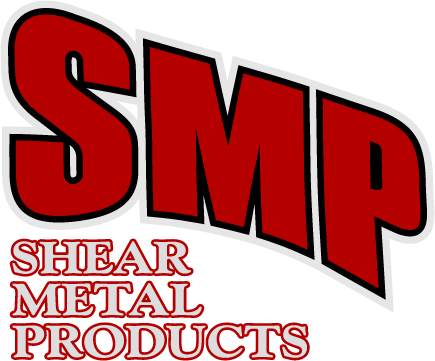
- August 27, 2025
- Steel Roof
- Building Strength from the Ground Up: The Role of Steel Roof and Floor Decks
Introduction
In construction, structural efficiency and reliability are paramount. Steel roof and floor
decks, once viewed simply as surfaces for roofing systems or concrete slabs, have
evolved into critical structural components. Today’s architects and engineers rely on
deck systems to provide not only a platform for trades but also to contribute directly to
the structural performance of the building.
At Shear Metal Products, we understand that a steel deck is far more than just a sheet of
corrugated steel. It is the backbone of lateral stability, a primary line of defense against
wind uplift, and a vital contributor to diaphragm shear capacity. Our specialized design team, combined with project-specific engineering and certified installation crews,
ensures that every deck system we supply and install integrates seamlessly into the
building’s structural framework.
The Role of Steel Roof and Floor Decks in Modern Construction
From Platform to Structural System
Traditionally, steel roof and floor decks were seen as substrates, something to support
roofing membranes or concrete topping. Today, they are recognized as integral
load-carrying elements that:
● Transfer horizontal forces (wind, seismic, and live loads) through diaphragm action.
● Provide structural continuity for the frame.
● Enhance fire resistance when combined with insulation or concrete.
This shift in perception has made the design, specification, and installation of deck systems far more demanding. No longer can decks be treated as “one size fits all.”
Each project requires careful evaluation of span conditions, load profiles, fastening methods, and compliance with building codes such as ULC and Factory Mutual standards.
Key Performance Considerations
1. Wind Uplift Resistance
Roofs are subjected to some of the harshest environmental forces, particularly wind
uplift. Steel roof decks act as the first line of structural defense, transferring uplift loads
through fasteners into the primary framing. Proper gauge selection, seam fastening, and
support spacing are essential to ensure performance under extreme conditions.
2. Live and Dead Load Capacity
Floor decks must carry both dead loads (self-weight, concrete topping, finishes) and
live loads (occupancy, equipment, transient forces). Engineers rely on deck profiles and
gauges that can achieve the necessary composite action with concrete slabs. Without an accurate gauge specification, excessive deflection or failure could compromise the entire structural system.
3. Diaphragm Shear and Lateral Stability
Steel decks function as horizontal diaphragms, transferring lateral forces (wind, seismic, or blast loads) across the structure to shear walls or braced frames. Diaphragm shear capacity is one of the most critical design parameters for decks in mid- and high-rise structures. Achieving this capacity requires precise fastening patterns, sidelap connections, and gauge thicknesses as detailed in engineered shop drawings.
4. Fire and Insurance Compliance (ULC & Factory Mutual)
Compliance with fire resistance standards is essential, especially in commercial and
industrial buildings. Roof decks may require ULC fire-rated assemblies, while
insurance-driven Factory Mutual (FM) approvals govern fastening patterns, insulation
systems, and material selection. Partnering with a contractor experienced in these
standards, such as Shear Metal, mitigates compliance risks.
Steel roof and floor decks aren’t just a base; they’re the backbone of today’s buildings. From resisting wind uplift to carrying live and dead loads, properly engineered deck systems deliver strength, stability, and safety at every level of construction.
Technical Aspects of Steel Deck Design
Deck Gauges and Profiles
Steel roof and floor decks are manufactured in a variety of profiles, each optimized for span length and load requirements. Common gauges range from 22 gauge for light-duty applications to 16 gauge for heavy-load industrial projects. Profile depth (e.g., 1.5”, 2”, or 3”) directly impacts span capacity and load distribution.
Fastening Systems
Proper fastening is fundamental to achieving diaphragm shear and uplift resistance.
Common fastening methods include:
● Welded fasteners (puddle welds, arc spot welds).
● Mechanical fasteners (screws, power-driven pins).
● Sidelap fasteners (button punching, seam welding, stitch screws).
Each fastening method is selected based on project-specific structural and fire code
requirements. Incorrect fastening patterns can significantly reduce diaphragm capacity
and compromise safety.
Integration with Concrete Slabs
In floor applications, composite deck systems are used where the deck acts as tensile
reinforcement for the concrete slab. Shear studs or embossments in the deck profile
ensure composite action between steel and concrete. This integration reduces overall
structural depth and material usage while enhancing load capacity.
The Shear Metal Advantage
Project-Specific Engineered Shop Drawings
At Shear Metal Products, we never take a “cookie-cutter” approach. Our specialized design team produces project-specific engineered shop drawings, detailing:
● Gauge and profile selection.
● Fastening patterns and sidelap connections.
● Fire and code compliance requirements.
● Coordination with structural steel framing and mechanical penetrations.
These shop drawings are not just paperwork—they are a roadmap for structural integrity. They ensure that every deck installed is tailored to the unique structural and architectural requirements of the project.
Certified Installation Crews
Execution in the field is as important as design on paper. Shear Metal provides CWB-certified installers who are trained in proper welding, fastening, and safety procedures. This certification guarantees that every deck is installed according to the engineered details and industry best practices.
Organized Project Management
Construction projects are complex, with multiple trades working in tight schedules. Our experienced project management team coordinates seamlessly with general contractors, engineers, and architects to ensure:
● On-time delivery and installation.
● Quality control throughout the process.
● Minimal disruption to other trades.
By maintaining rigorous oversight, Shear Metal ensures that deck systems are integrated smoothly into the broader construction sequence.
Case in Point: Why “One Size Fits All” Doesn’t Work
Consider two projects:
● A single-story industrial warehouse requiring wide-span roof decking to resist uplift and support heavy mechanical equipment.
● A multi-story office tower where composite floor decks must provide diaphragm action and fire resistance.
Though both use steel decks, the engineering solutions are entirely different. Using the same gauge, fastening, or detailing across both would be not only inefficient but also unsafe. This is why customized, engineered solutions are imperative—and why Shear Metal’s approach ensures compliance and safety across all project types.
Long-Term Benefits of a Properly Designed Deck
System
When designed, detailed, and installed correctly, steel roof and floor decks provide:
● Structural reliability: Enhanced lateral stability and load-carrying capacity.
● Code compliance: Meeting ULC, Factory Mutual, and local building requirements.
● Durability: Resistance to corrosion, fire, and environmental loads.
● Cost efficiency: Optimized gauge and fastening selections reduce unnecessary material usage.
● Construction speed: Prefabricated, lightweight components accelerate installation.
In contrast, poorly specified or installed deck systems can result in excessive deflection,
Failure under wind uplift, or non-compliance with fire codes, are risks that can compromise
the entire project.
Conclusion
Steel roof and floor decks are not ancillary building components; they are the structural backbone of modern construction. From resisting wind uplift to providing diaphragm shear and fire compliance, the deck plays a vital role in ensuring structural integrity and safety.
At Shear Metal Products, we bring a holistic approach that combines engineered shop drawings, certified installation, and organized project management to deliver deck systems that meet today’s demanding standards. With every project, our mission is simple: to build strength from the ground up.
